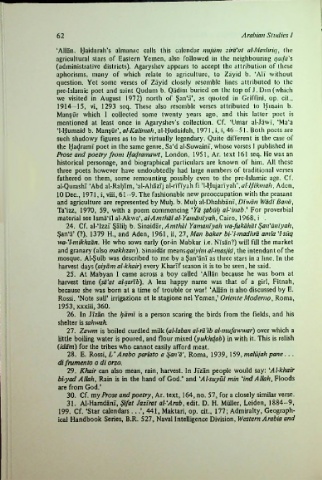Page 76 - Arabian Studies (I)
P. 76
62 Arabian Studies I
‘Allan. Haidarah’s almanac calls this calendar nujum zira'at al-Mashriq, the
agricultural stars of Eastern Yemen, also followed in the neighbouring qada's
(administrative districts). Agaryshev appears to accept the attribution of these
aphorisms, many of which relate to agriculture, to Zayid b. ‘Alf without
question. Yet some verses of Zayid closely resemble lines attributed to the
pre-Islamic poet and saint Qudum b. Qadim buried on the lop of J. Dm (which
we visited in August 1972) north of San‘a’, as quoted in Griffini, op. cit.,
1914-15, vi, 1293 seq. These also resemble verses attributed to Husain b.
Mansur which I collected some twenty years ago, and this latter poet is
mentioned at least once in Agaryshev’s collection. Cf. ‘Umar al-Jawf, ‘Ma‘a
’1-Humaid b. Mansur’, al-Kalimah, al-Hudaidah, 1971, i, i, 46-51. Both poets are
such shadowy figures as to be virtually legendary. Quite different is the case of
the Hadramf poet in the same genre, Sa‘d al-Suwainf, whose verses I published in
Prose and poetry from Hadramawt, London, 1951, Ar. text 161 seq. He was an
historical personage, and biographical particulars are known of him. All these
three poets however have undoubtedly had large numbers of traditional verses
fathered on them, some remounting possibly even to the pre-Islamic age. Cf.
al-Qurash! ‘Abd al-Rahlm, ‘al-Ahazfj al-rffiyah fi ’1-HujarTyah’,al-Hikmah, Aden,
10 Dec., 1971, i, viii, 61-9. The fashionable new preoccupation with the peasant
and agriculture are represented by Muh. b. Muh al-Dhahbanf,Z)nvfl» WadTBarn,
Ta‘izz, 1970, 59, with a poem commencing *Ya sabuh al-'inab.’ For proverbial
material see Isma‘fl al-Akwa‘, al-Amthalal-YamanTyah, Cairo, 1968, i-.
24. Cf. al-‘Izzf Salih b. Sinaidar,i4/?tf/w/ Yamaniyah wa-fukahat San'anTyah,
§an‘a* (?), 1379 H., and Aden, 1961, ii, 27, Man bakar bi-'l-madhra amla 7-suq
wa-‘l-mikhzan. He who sows early (or-in Mabkar i.e. NIsan?) will fill the market
and granary (also makhzan). Sinaidar means qaiyim al-masjid, the intendant of the
mosque. Al-Sulb was described to me by a San‘anT as three stars in a line. In the
harvest days (aiyam al-khair) every KharTf season it is to be seen, he said.
25. At Mabyan I came across a boy called ‘Allan because he was born at
harvest time (sa'at al-sarib). A less happy name was that of a girl, Fitnah,
because she was born at a time of trouble or war! ‘Allan is also discussed by E.
Rossi, ‘Note sulT irrigazione et le stagione nel Yemen,’ Oriente Moderno, Roma,
1953, xxxiii, 360.
26. In Jfzan the harm is a person scaring the birds from the fields, and his
shelter is sahwaft
27. Zawm is boiled curdled milk (al-laban al-raib al-mufawwar) over which a
little boiling water is poured, and flour mixed (yukhdab) in with it. This is relish
(idam) for the tribes who cannot easily afford meat.
28. E. Rossi, L* Arabo parlato a San‘a\ Roma, 1939,159, malujah pane...
di frumento o di orzo.
29. Khair can also mean, rain, harvest. In Jfzan people would say: ‘Al-khair
bi-yad Allah, Rain is in the hand of God.* and 4Al-suyul min 'ind Allah, Floods
are from God.’
30. Cf. my Prose and poetry, Ar. text, 164, no. 57, for a closely similar verse.
31. Al-Hamdanf, Sifat Jazirat al-'Arab, edit. D. H. Muller, Leiden, 1884-9,
199. Cf. ‘Star calendars ...’, 441, Maktari, op. cit., 177; Admiralty, Geograph
ical Handbook Series, B.R. 527, Naval Intelligence Division, Western Arabia and

